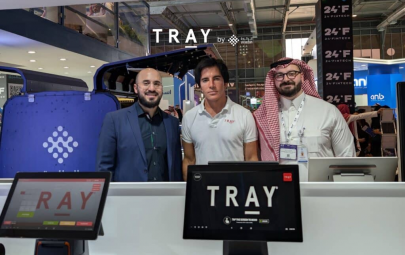Out of Line: How Restaurant Operators Can Utilize The Cloud To Maximize Performance

By: Peter Kellis, Founder & CEO, TRAY
In my professional life, I pride myself on being a patient executive who always looks ahead and works systematically towards long-term goals. But in my personal life, like so many people I know, my patience wanes when it comes to having to wait in lines at a coffee shop, a restaurant – wherever.
Patience may be a virtue, but not when it impedes performance. Long lines are a symbol of inefficiency, and inefficiency blocks productivity and wastes time. To further frustrate matters, we have technology and tools available to us today to streamline workflows to rid ourselves of inefficiencies.
I’ve heard from countless restaurant operators about their own similar frustrations, especially in relation to the countless hours devoted to trying to improve wait times and reduce lines. Many of them end up looking to their aging point-of-sale (POS) systems, which quickly become a blocker to new innovative strategies.
So, when restaurant operators go looking for ways to innovate, they’re inevitably met with a need to throw out all the current capital investments to get to the needed improvements – a proposition that results in difficult ROIs. On top of these impossible economics, the upgrade process is incredibly time-consuming and massively expensive. Updating such a massive and integral part of the business can take years, multiple decision makers and tens of thousands of dollars per store.
Consider just the cost of POS hardware: There’s often a nominal fee for a simple card reader, to more than $1200 for a complete register, according to Forbes Advisor. Multiply that single register cost for numerous locations, especially for enterprise businesses, and the expense is significant. The result is an expensive frustration as operators wait endlessly (and spend much needed funds) to make the changes their restaurants need to thrive.
For restaurant operators, it’s time to stop waiting, wasting time and throwing good money after bad. With readily available technology, there’s a way for operators to effectively skip ahead in the line, accessing updates that can have an immediate effect without destroying their bottom lines. And, like so many technologies that have improved efficiencies, it’s all about using “the cloud.”
Switching to cloud-based technology used on legacy hardware can be an incredibly smart option for restaurant owners who want to improve business operations without long delays and costly hardware overhauls. The restaurant point-of-sale (POS) system, using access to cloud-based data and seamless software updating, can bring important innovations to operators without the wait and expense.
A cloud-based POS provides benefits that go well beyond what traditional hardware platforms can do alone:
Accessibility and Cost Savings
By converting to cloud-based POS systems, restaurant owners can access their data and manage their operations remotely, anytime and anywhere. Further, unlike traditional hardware-based systems, cloud-based solutions do not require substantial upfront investments in expensive equipment. Instead, they operate on a subscription-based model, allowing businesses to pay for only the services they need. This eliminates the need for costly hardware upgrades, reducing financial burden.
Flexibility and Integration Ease
Cloud-based POS systems offer unparalleled flexibility and scalability for restaurants of all sizes. Since the software resides in the cloud, updates and maintenance are performed automatically, saving valuable time and resources. Additionally, cloud-based systems enable seamless integration with other business applications, such as inventory management and customer relationship management (CRM) tools. This integration enhances overall efficiency and streamlines operations, leading to improved guest service and higher profitability.
Data Security
One of the primary concerns for restaurant operators is the security and accessibility of guest data. Cloud-based POS systems provide robust data security measures, including encryption and regular backups, protecting sensitive customer information. Moreover, since the data is stored in the cloud, it is accessible even in the event of hardware failure or physical damage, ensuring crucial business data is always available and can be recovered swiftly, reducing downtime and potential losses.
Insights and Analytics
Cloud-based POS systems empower restaurant operators with real-time insights and analytics, enabling them to make informed business decisions. Through centralized reporting and analytics tools, operators can access sales data, inventory levels and customer preferences in real-time. This valuable information helps in optimizing menu offerings, identifying trends, and creating targeted marketing campaigns leading to increased guest satisfaction and revenue.
These can all be delivered on a much timelier basis. Until recently, restaurant owners and operators had limited choices in regard to their POS system: continue the use of a rapidly aging and potentially antiquated infrastructure, or completely overhaul the entire system to implement the latest and greatest offering for thousands of dollars, pounds of machine waste and countless headaches.
Cloud-based technology has revolutionized the restaurant industry by offering a powerful alternative to traditional POS systems, and a win-win situation for restaurant operators who want to focus on serving their guests while cost-effectively, and efficiently running their business.
No more long waits for important updates. No more massive expenditures on hardware overhauls. A cloud-based POS allows operators to constantly innovate and improve without the hassle and frustration. I encourage the industry to step out of line and into a more efficient and effective solution for their restaurants.
##
About Peter Kellis
As Founder & CEO, Peter is responsible for leading the company and product vision at TRAY. Peter holds undergraduate and graduate degrees in Electrical Engineering and Computer Science from MIT, and holds over 35 patents in data replication technologies.
Categories:



